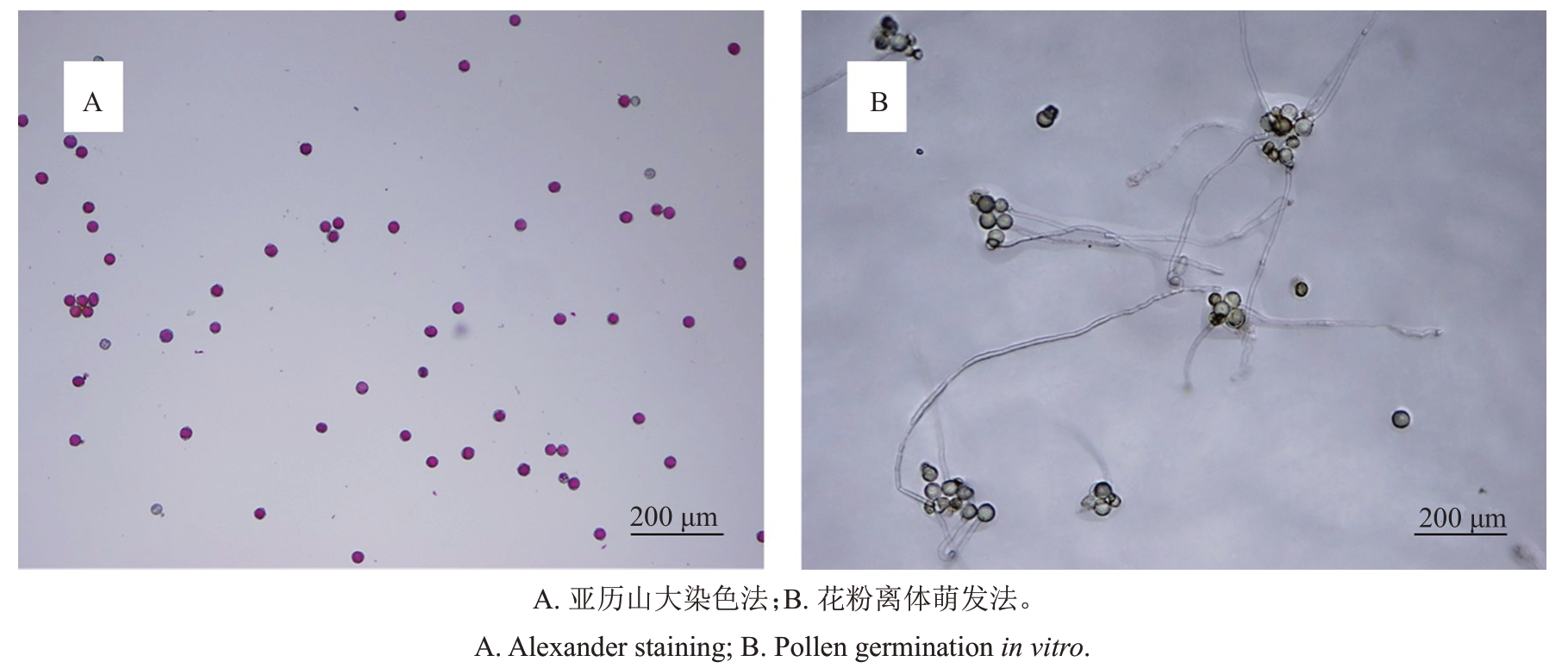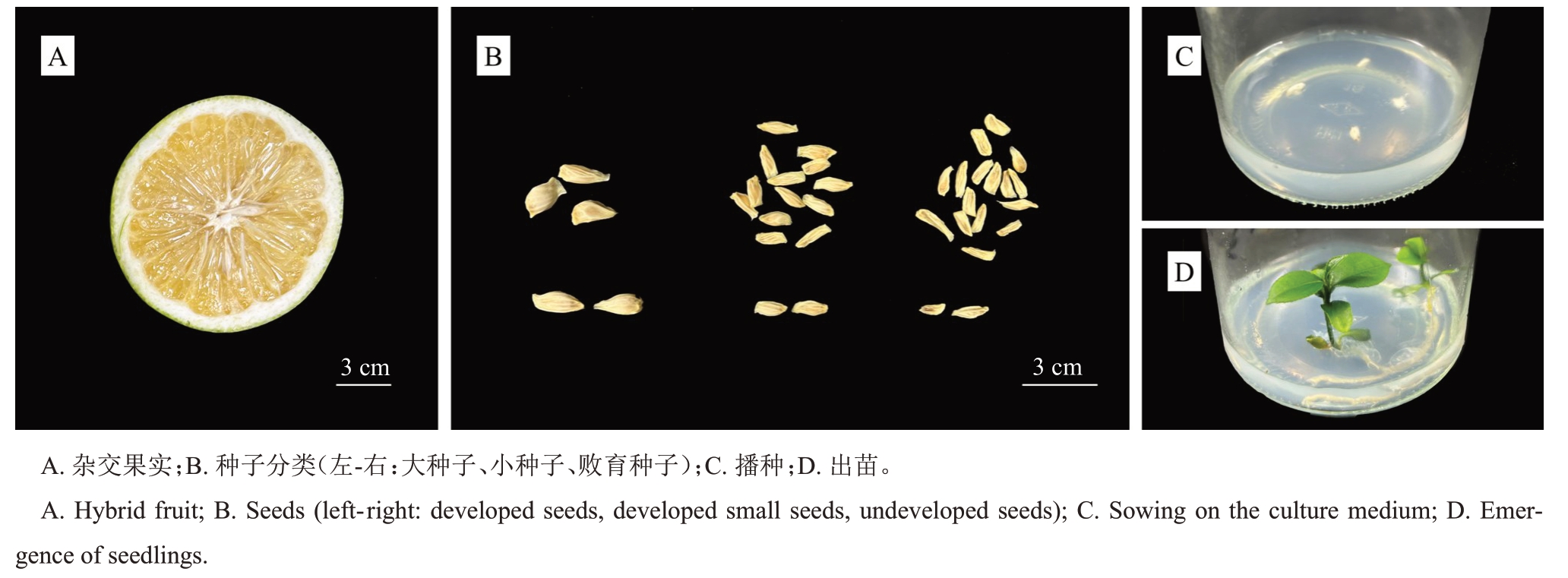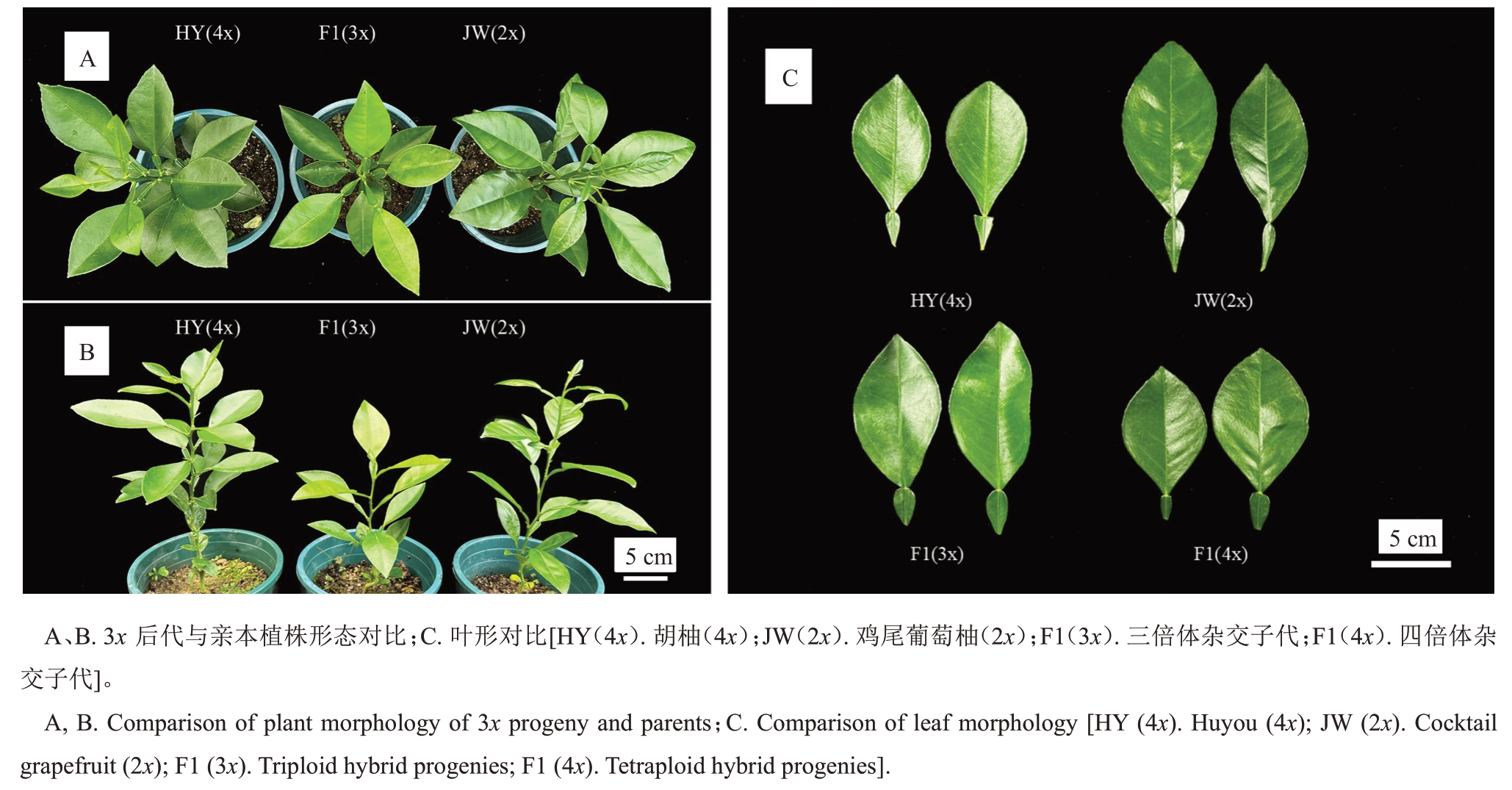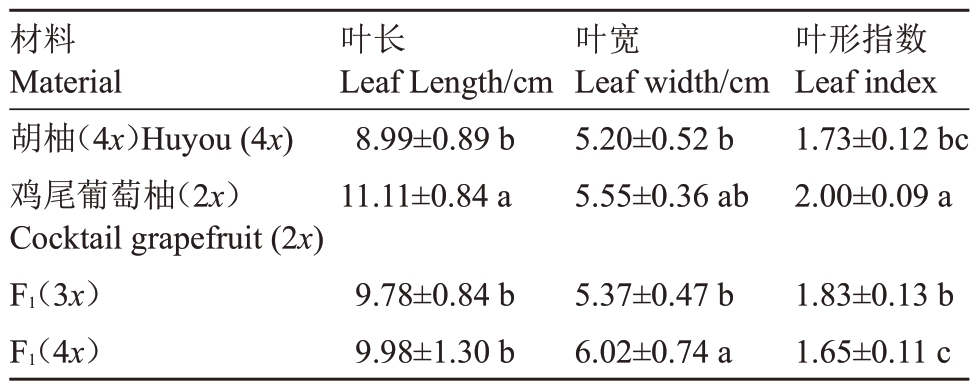葡萄柚风味独特,可用作鲜食和加工,是一种具有市场潜力的柑橘品种。鸡尾葡萄柚(Citrus paradisi‘Cocktail’)由暹罗甜柚和弗鲁亚橘杂交选育而来[1],具有低酸,水分多,苦味轻的特点,受到消费者青睐,目前在浙江、广西、广东、江西、上海、湖北等长江以南地区有引种栽培[2]。但鸡尾葡萄柚存在种子多、抗寒性差的缺点,单果种子数约30 粒,不便鲜食。另外,鸡尾葡萄柚树体抗冻性弱,在低于-5 ℃环境下容易遭遇冻害[1],在一定程度上阻碍了其扩大引种和栽培生产。
三倍体植株具有果实无核或少核的特征,作为多倍体,还具有生长旺盛、果实增大、抗逆性增强等优势。在柑橘育种中,通过四倍体和二倍体倍性杂交是获得三倍体无核后代的有效途径,选取优良且具有特定性状的亲本可以将亲本优势转移到子代[3]。刘承浪等[4]以早熟且高糖低酸的品种东试早柚作为二倍体母本,与3 个四倍体柑橘品种杂交,培育并鉴定了128 株三倍体杂交后代,以获得兼具双亲优良性状的无核新种质。为选育无核、抗寒、抗病的高酸柑橘品种,Viloria 等[5]使用柠檬及酸橙四倍体种质与二倍体进行杂交,从35 个倍性杂交组合中获得了近650 株三倍体植株。西班牙从1996 年起,针对柑橘果实无核和丰富果实成熟期等育种目标,通过倍性杂交,培育了Garbí、Safor、Alborea、Albir 等三倍体品种,满足了市场对无核柑橘周年供应的需要[6]。近几年来,华中农业大学以异源四倍体体细胞杂种以及双二倍体为父本与大量性状优良的二倍体柑橘进行杂交,配置了80 余个倍性杂交组合,创制了3000 余份三倍体植株,为后续筛选优质无核柑橘新品种提供了丰富的三倍体资源[7]。
常山胡柚(C.aurantium‘Changshanhuyou’)为中国特色地方柑橘品种,具有果实品质优良以及抗寒性强等特点,种子为单、多胚混合型[8]。为弥补鸡尾葡萄柚种子多和树体不耐寒的缺点,以笔者课题组前期创制的胡柚双二倍体为母本、二倍体鸡尾葡萄柚为父本进行倍性杂交。通过杂交授粉、种子组织培养、幼苗流式细胞仪鉴定倍性和SSR分子标记鉴定遗传组成,培育并鉴定出了胡柚与鸡尾葡萄柚的三倍体和四倍体杂交后代,为选育抗寒、低酸、无核的杂种葡萄柚新品种奠定了种质基础。
1 材料和方法
1.1 材料
以定植于浙江农林大学校园内的四倍体胡柚(C.aurantium‘Changshanhuyou’)为母本、二倍体鸡尾葡萄柚(C.paradisi‘Cocktail’)为父本,进行倍性杂交,创制三倍体无核新种质。
1.2 花粉采集与活力测定
鸡尾葡萄柚花粉收集参考谢善鹏[9]的方法,在4 ℃避光环境下短时间保存备用。授粉前使用亚历山大染色法[10]和花粉离体萌发法对鸡尾葡萄柚花粉活力进行检测,确保花粉活性足以进行杂交。花粉离体萌发法参考肖金平等[11]的方法并作适当修改。将花粉均匀涂抹于含10%蔗糖+0.01%硼酸+0.03%CaCl2+1%琼脂的固体萌发培养基上,用湿盒保湿,(25±1)℃温度下暗培养20 h。各试验统计花粉总数在500 个以上,花粉活力/%=有活力的花粉/花粉总数×100。
1.3 杂交授粉及胚培养
4月中旬在四倍体胡柚开花期挑选晴朗天气进行人工授粉,授粉参考解凯东等[12]的方法。11 月中旬果实成熟期,采集授粉得到的果实带回实验室剥取种子。根据种子大小以及发育程度,将其分为大种子(大小正常、内部充实)、小种子(大小约为正常种子1/6~1/3、内部充实)和败育种子(种子内部败育),并分别统计数量。所有种子用1 mol·L-1 NaOH洗去表面残留果胶,流水冲洗3~4 h 后,在无菌环境下将大种子和小种子接种于MT 培养基中,败育种子接种在MT+1.0 mg·L-1 GA3的培养基中。培养环境:温度(26±1)℃,湿度70%左右,日光照16 h。待植株长出4~5 枚功能叶和完整的根系时,将其移栽至温室继续培养。
1.4 再生植株倍性鉴定
再生植株的细胞倍性通过流式细胞仪(Cy-Flow® Ploidy Analyser,Sysmex,Germany)鉴定,样品处理使用CyStain™UV Precise P倍性分析试剂盒(Sysmex,Germany),具体方法如下:以二倍体植株作为对照,用剪刀取0.5 cm2左右的新鲜叶片,置于塑料培养皿,在样品周围均匀加入200 μL细胞核裂解液(CyStain™UV Precise P Nuclei Extraction Buffer),迅速用锋利的刀片切至匀浆,随后加入800 μL荧光染液(CyStain™UV Precise P Staining Buffer)混匀。混液用50 μm 细胞滤网过滤至上样管,使用流式细胞仪上样分析。检测完毕后,检测结果使用Origin 2021进行数据分析以及作图。
1.5 基因组DNA提取与遗传来源分析
使用CTAB 法提取叶片基因组DNA,参考程运江等[13]的方法并作适当修改。提取的DNA使用1%琼脂糖凝胶电泳检测后置于-80 ℃冰箱保存。采用SSR分子标记鉴定后代遗传组成,4对SSR引物源自相关参考文献(表1),由杭州有康生物科技有限公司合成。PCR体系(10 μL)为:无菌水2 μL,正反向引物各1 μL,DNA模板1 μL,2×Accurate Taq酶5 μL。PCR扩增程序为:94 ℃预变性5 min;94 ℃变性1 min;58 ℃退火30 s;72 ℃延伸30 s;33个循环后72 ℃延伸10 min,10 ℃保存。扩增产物加入2 μL 6×Loading Buffer(TaKaRa)混合,使用12%聚丙烯酰胺凝胶电泳分离条带。
表1 SSR 引物信息
Table 1 Information of SSR primers

SSR引物名称SSR primer name F14 P72 MEST86 CAG01正向序列(5'-3')Forward sequence(5'-3')GCTCCTCGAATGAGAATGAAATGA GTGAGGCAAAACGGAAAGAG CCTCTCTGGCTTCTGGATTG AACACTCGCACCAAATCCTC反向序列(5'-3')Reverse sequence(5'-3')TGGTTGTGCGAAAATGAAGAGATA GGGCCCATACAACGTAGAAG CCAACTGACACTAATCCTCTTCC TAAATGGCAACCCCAGCTTTG参考文献Reference[14][15][16][17]
1.6 杂交后代形态学比较
杂交后代以父母本1 年生实生苗为对照,对其植株上春梢成熟叶片的形状、长宽、叶形指数进行比较和测量。叶形指数计算公式为:叶形指数=主叶长度/主叶宽度,使用SPSS 27.0 对计算结果进行多重比较和方差分析。
2 结果与分析
2.1 花粉活力测定
采用亚历山大染色法和花粉离体萌发法对父本鸡尾葡萄柚花粉活性进行检验(图1),亚历山大染色法检测的花粉染色活力为89.40%,花粉离体萌发法检测的花粉萌发率为30.02%。两种检测方法均表明鸡尾葡萄柚花粉具有良好的花粉活力,能作为父本用于杂交。

图1 两种方法下的花粉活力检测结果
Fig.1 Results of pollen vitality detection by two methods
2.2 杂交授粉结果
在四倍体胡柚花期使用鸡尾葡萄柚花粉授粉,共授粉40 朵花,坐果19 个,坐果率为47.5%。11 月采收授粉的果实后共获得种子230 粒,种子分组后再接种于培养基内培养成苗(图2)。其中大种子56粒(平均每果3.0 粒),再生植株49 株,成苗率87.50%;小种子117 粒(平均每果6.2 粒),再生植株69 株,成苗率58.97%;败育种子57 粒(平均每果3.0粒),再生植株4株,成苗率7.02%。

图2 胡柚(4x)×鸡尾葡萄柚(2x)杂交果实、种子分类及植株再生过程
Fig.2 Fruits of Huyou(4x)×Cocktail grapefruit(2x),seeds sorting and regeneration of hybrid progenies
2.3 再生植株倍性分析
采用流式细胞仪对杂交获得的122株再生植株进行倍性分析(图3)。在122 株检测植株中,有39株为三倍体,83 株为四倍体,三倍体后代数量占31.96%。其中,大种子再生后代有4.08%为三倍体,共2 株;小种子再生后代有50.72%为三倍体,共35株。败育种子仅获得4 株再生植株,其中三倍体后代2 株,四倍体后代2 株。在所有再生植株中,三倍体主要集中于小种子的再生后代,且数量和比例远高于其他两个种子类型。

图3 三倍体后代和二倍体混样(A)以及四倍体后代和二倍体混样(B)的流式细胞仪峰图
Fig.3 Ploidy analysis result of triploid(A)and tetraploid(B)progenies by flow cytometry with diploid as a control
2.4 再生植株遗传来源分析
对再生获得的39株三倍体植株,以及随机挑选的22株四倍体植株,使用4对SSR引物进行杂合性分析(图4)。其中,SSR 引物P72、MEST86、CAG01分别仅能鉴定部分后代,而SSR 引物F14 在鉴定的39 株三倍体后代中均含有双亲差异条带。结果显示,所有三倍体后代均含有父母本的特征条带,为四倍体胡柚和鸡尾葡萄柚杂交所得。在检测的22 株四倍体后代中,21 株只含有母本特征条带,并非通过鸡尾葡萄柚杂交所得,仅有1株(7号)包含了父母本的特征条带,为杂交产生的四倍体(图5)。

图4 不同SSR 引物对三倍体后代的遗传鉴定
Fig.4 Identification of the genetic composition of triploid progenies by SSR marker

图5 SSR 引物F14 遗传鉴定结果
Fig.5 Identification of the genetic composition using SSR marker F14
2.5 杂交后代植株形态及叶片特征比较
杂交后代以双亲1年生实生苗为对照进行植株形态与叶片形态对比(图6)。母本、父本、3x杂交后代以及本次获得的1株4x杂交后代的叶形指数分别为1.73、2.00、1.83、1.65。杂交获得的三倍体和四倍体后代叶形指数更接近四倍体母本,与母本差异不显著,但都与父本有显著差异。三倍体杂交后代叶形指数介于父母本之间,但本次鉴定得到的1 株杂合四倍体植株叶片相对于四倍体母本更宽、更接近圆形(表2),且叶形指数显著小于三倍体。

图6 杂交后代与亲本植株形态和叶片比较
Fig.6 The plant and leaf morphology of hybrid progenies compared with parents
表2 叶片形态指标比较
Table 2 Comparison of leaf indices

注:不同小写字母表示差异显著(p<0.05)。
Note:Different small letters indicate significant difference at p<0.05 level.
材料Material胡柚(4x)Huyou(4x)鸡尾葡萄柚(2x)Cocktail grapefruit(2x)F1(3x)F1(4x)叶长Leaf Length/cm 8.99±0.89 b 11.11±0.84 a叶宽Leaf width/cm 5.20±0.52 b 5.55±0.36 ab叶形指数Leaf index 1.73±0.12 bc 2.00±0.09 a 9.78±0.84 b 9.98±1.30 b 5.37±0.47 b 6.02±0.74 a 1.83±0.13 b 1.65±0.11 c
3 讨 论
倍性杂交除了获得三倍体后代的无核特性外,亲本选配对获得符合育种目标的杂交后代有很大影响。植物抗寒性受基因的影响。章文才等[18]研究发现,在来自不同亲本组合的柑橘自然杂交后代中,F1代的抗寒性往往介于亲本之间,推测选择抗寒性较强的亲本可有机会提升后代的抗寒能力。通过抗寒性强的种质培育品质优良的抗寒后代在葡萄育种中已有大量实践以及成功案例[19]。成年常山胡柚枝条致死温度在-13.7 ℃[8],在冬季表现出较强的抗冻性。由于三倍体植物在解剖学及细胞学特性、光合特性和代谢产物等方面表现出良好的抗逆性能[20-21],因此,鸡尾葡萄柚异源三倍体树体的抗冻性将可能得以提高。另外,鸡尾葡萄柚和胡柚的果皮和果肉内均含有丰富的类黄酮成分[22],且均为低呋喃香豆素含量的品种[23],杂交后代有望结出类黄酮含量较高、呋喃香豆素含量低的果实。
4x×2x 杂交组合下,三倍体胚一般发育正常,无需提前进行胚挽救离体培养,与2x × 4x 组合相比,在三倍体后代的获得上具有更高的效率,节约大量人力和物力。该杂交组合下获得的三倍体种子内胚和胚乳的倍性比为3∶5,影响了胚发育的起止时间,导致其种子大小一般只有正常种子的1/6~1/3,故小种子可以作为筛选三倍体种子的特征之一[24]。在本研究中,种子收集后根据大小以及发育程度将其分为大种子、小种子和败育种子,以观察种子形态与再生植株倍性的关联性。Esen等[25]以Lisbon柠檬等四倍体柑橘为母本,授以四倍体花粉时,获得的种子全部或绝大部分为正常大小的种子;而在授以二倍体花粉时,所获得的种子全部为小种子。Aleza等[26]进行了多个4x×2x 柑橘组合的杂交,杂交果实中99.3%为小粒种子,且再生后代绝大部分为三倍体。在本研究中,89.74%的三倍体出现于小种子中,与前人研究结果基本一致。但小种子中仍有近一半的再生后代为四倍体,且在大种子中也获得了2 株三倍体,表明不同基因型的柑橘作为亲本进行倍性杂交,三倍体后代不完全来自小种子,小种子发育而来的植株也不一定全部为三倍体。
简单重复序列(simple sequence repeat,SSR)标记是一种共显性遗传的分子标记,具有重复性好、多态性高、操作简单等优点,可用于鉴定杂交后代,提高育种效率。在本研究中,再生的39株三倍体后代均包含父母本的特征条带,可判断它们都是胡柚与鸡尾葡萄柚的杂交后代。除三倍体外,种子再生后还获得了部分四倍体。鉴定的22株四倍体中,21株仅含有母本胡柚的特征条带,非双亲杂交产生,来源可能为:(1)胡柚种子约60%为多胚[8],四倍体后代为珠心胚再生而来。但试验中未对胡柚种子进行单多胚分级,无法较为准确地判断四倍体后代来自珠心胚还是为有性后代。(2)部分四倍体后代为母本自交而来,等位基因出现重组分离,如四倍体后代中的第14 号单株。本研究中大部分果实内同时含有大种子和小种子,其中大种子再生后绝大部分为四倍体。Esen 等[25]在研究中同时授以四倍体母本4x 及2x的混合花粉,也出现了大种子和小种子同时产生的情况,本次授粉过程中部分花的柱头可能受到了母本花粉的污染,导致同一果实内同时产生了四倍体和三倍体后代。二倍体柑橘中存在2n 卵和2n 花粉,四倍体在减数分裂时也可能产生n、2n 和3n 配子[27],本试验中有1 株四倍体后代包含了父本和母本的特征条带,且仅含有一条来自母本的等位基因,推测可能是由鸡尾葡萄柚未减数的2n 雄配子与四倍体胡柚的2n雌配子杂交而来,四倍体后代详细的遗传来源还有待进一步研究。
4 结 论
笔者在本研究中以四倍体胡柚为母本,与二倍体鸡尾葡萄柚有性杂交,经组织培养、流式细胞仪鉴定倍性、SSR 分子标记鉴定遗传组成,共获得39 株杂合三倍体后代和1 株杂合四倍体后代,为今后筛选优质、耐寒、无核的杂种葡萄柚品种提供了种质基础。
[1] 柯甫志,徐建国,罗君琴,聂振朋,王平,孙建华.鸡尾葡萄柚的品种特性及栽培技术[J].浙江柑橘,2015,32(1):16-18.KE Fuzhi,XU Jianguo,LUO Junqin,NIE Zhenpeng,WANG Ping,SUN Jianhua. Variety characteristics and cultivation techniques of Cocktail grapefruit[J]. Zhejiang Ganju,2015,32(1):16-18.
[2] 郑丽,谌丹丹,刘慧宇,夏文娟,徐绳武,鄢华捷,杨阳,李鸿昌,向守宏,李长林.鸡尾葡萄柚在湖北部分地区的引种表现及栽培技术[J].中国南方果树,2021,50(6):17-21.ZHENG Li,CHEN Dandan,LIU Huiyu,XIA Wenjuan,XU Shengwu,YAN Huajie,YANG Yang,LI Hongchang,XIANG Shouhong,LI Changlin. Performance of Cocktail grapefruit introduced to Hubei province and its cultivation techniques[J].South China Fruits,2021,50(6):17-21.
[3] 党江波,崔璐璐,韩国辉,李彩,向素琼,郭启高,梁国鲁.柑橘倍性操作技术与育种现状、难点及展望[J].园艺学报,2021,48(4):791-810.DANG Jiangbo,CUI Lulu,HAN Guohui,LI Cai,XIANG Suqiong,GUO Qigao,LIANG Guolu.Ploidy manipulation and citrus breeding:Current status,problems and prospects[J]. Acta Horticulturae Sinica,2021,48(4):791-810.
[4] 刘承浪,冯迪,曹宗洪,陶亚文,徐祥增,高世德,岳建强,谢宗周,叶俊丽,柴利军,郭文武,邓秀新.以东试早柚为母本创制柑橘三倍体种质资源[J].果树学报,2023,40(10):2041-2049.LIU Chenglang,FENG Di,CAO Zonghong,TAO Yawen,XU Xiangzeng,GAO Shide,YUE Jianqiang,XIE Zongzhou,YE Junli,CHAI Lijun,GUO Wenwu,DENG Xiuxin. Creation of triploid seedling plants of citrus by crossing Dongshizao pummelo female with tetraploid male parents[J].Journal of Fruit Science,2023,40(10):2041-2049.
[5] VILORIA Z,GROSSER J W.Acid citrus fruit improvement via interploid hybridization using allotetraploid somatic hybrid and autotetraploid breeding parents[J].Journal of the American Society for Horticultural Science,2005,130(3):392-402.
[6] NAVARRO L,ALEZA P,CUENCA J,JUÁREZ J,PINA J A,ORTEGA C,NAVARRO A,ORTEGA V. The mandarin triploid breeding program in Spain[J]. Acta Horticulturae,2015(1065):389-395.
[7] GUO W W,XIE K D,WU X M,XIE Z Z,XU Q,DENG X X.Ploidy manipulation via cell engineering for citrus improvement facilitated by application of molecular markers[J].Acta Horticulturae,2018(1203):105-110.
[8] 贝增明,叶杏元.常山胡柚特性与栽培技术[M].北京:中国科学技术出版,2003:21-23.BEI Zengming,YE Xingyuan. Characteristics and cultivation techniques of Changshan Huyou[M].Beijing:Science and Technology of China Press,2003:21-23.
[9] 谢善鹏.柑橘11 个地方品种资源四倍体高效发掘及三倍体新种质创制[D].武汉:华中农业大学,2022.XIE Shanpeng.Efficient exploration of tetraploid seedlings from 11 local citrus cultivars and production of triploid plants[D].Wuhan:Huazhong Agricultural University,2022.
[10] ALEXANDER M P.A versatile stain for pollen fungi,yeast and bacteria[J].Stain Technology,1980,55(1):13-18.
[11] 肖金平,谭金娟,刘海琳,陈力耕,叶伟其,程文亮.丽椪2 号椪柑无核机制研究[J].果树学报,2007,24(4):421-426.XIAO Jinping,TAN Jinjuan,LIU Hailin,CHEN Ligeng,YE Weiqi,CHENG Wenliang.Studies on the seedless mechanism of Lipeng No. 2 ponkan (Citrus reticulata)[J]. Journal of Fruit Science,2007,24(4):421-426.
[12] 解凯东,彭珺,袁东亚,强瑞瑞,谢善鹏,周锐,夏强明,伍小萌,柯甫志,刘高平,GROSSER J W,郭文武.以本地早橘和槾橘为母本倍性杂交创制柑橘三倍体[J].中国农业科学,2020,53(23):4961-4968.XIE Kaidong,PENG Jun,YUAN Dongya,QIANG Ruirui,XIE Shanpeng,ZHOU Rui,XIA Qiangming,WU Xiaomeng,KE Fuzhi,LIU Gaoping,GROSSER J W,GUO Wenwu.Production of citrus triploids based on interploidy crossing with Bendizao and Man tangerines as female parents[J]. Scientia Agricultura Sinica,2020,53(23):4961-4968.
[13] 程运江,伊华林,庞晓明,郭文武,邓秀新.几种木本果树DNA的有效提取[J].华中农业大学学报,2001,20(5):481-483.CHENG Yunjiang,YI Hualin,PANG Xiaoming,GUO Wenwu,DENG Xiuxin. An efficient method for genomic DNA extraction from woody fruit plants[J].Journal of Huazhong Agricultural,2001,20(5):481-483.
[14] CHEN C X,ZHOU P,CHOI YA,HUANG S,JR GMITTER F G.Mining and characterizing microsatellites from citrus ESTs[J].Theoretical and Applied Genetics,2006,112(7):1248-1257.
[15] 王福生,江东.应用cpSSR 和EST-SSR 标记进行柑橘特异种质资源遗传背景研究[J].园艺学报,2010,37(3):465-474.WANG Fusheng,JIANG Dong. Studies on genetic background of important germplasm resources among citrus based on cpSSR and EST-SSR marker[J].Acta Horticulturae Sinica,2010,37(3):465-474.
[16] GARCÍA-LOR A,LURO F,NAVARRO L,OLLITRAULT P.Comparative use of InDel and SSR markers in deciphering the interspecific structure of cultivated citrus genetic diversity:A perspective for genetic association studies[J]. Molecular Genetics and Genomics,2012,287(1):77-94.
[17] BARKLEY N A,ROOSE M L,KRUEGER R R,FEDERICI C T. Assessing genetic diversity and population structure in a citrus germplasm collection utilizing simple sequence repeat markers (SSRs)[J]. Theoretical and Applied Genetics,2006,112(8):1519-1531.
[18] 章文才,陈吉笙.柑桔的越冬栽培及抗寒品种的选育[J].园艺学报,1962,1(1):15-28.ZHANG Wencai,CHEN Jisheng. Winter cultivation of citrus and breeding of cold resistant varieties[J].Acta Horticulturae Sinica,1962,1(1):15-28.
[19] 刘军,王小伟,魏钦平,鲁韧强,高照全.世界葡萄抗寒育种的成就与展望[J].果树学报,2004,21(5):461-466.LIU Jun,WANG Xiaowei,WEI Qinping,LU Renqiang,GAO Zhaoquan. Achievements and prospect of world cold-resistant grape breeding[J].Journal of Fruit Science,2004,21(5):461-466.
[20] LOURKISTI R,FROELICHER Y,HERBETTE S,MORILLON R,TOMI F,GIBERNAU M,GIANNETTINI J,BERTI L,SANTINI J. Triploid citrus genotypes have a better tolerance to natural chilling conditions of photosynthetic capacities and specific leaf volatile organic compounds[J]. Frontiers in Plant Science,2020,11:330.
[21] LOURKISTI R,OUSTRIC J,QUILICHINI Y,FROELICHER Y,HERBETTE S,MORILLON R,BERTI L,SANTINI J. Improved response of triploid citrus varieties to water deficit is related to anatomical and cytological properties[J].Plant Physiology and Biochemistry,2021,162:762-775.
[22] XI W P,FANG B,ZHAO Q Y,JIAO B N,ZHOU Z Q. Flavonoid composition and antioxidant activities of Chinese local pummelo (Citrus grandis Osbeck.) varieties[J]. Food Chemistry,2014,161:230-238.
[23] 马丽丽.不同柑橘种质资源中呋喃香豆素组成的评价[D].武汉:华中农业大学,2013.MA Lili.Composition of furanoumarins in different citrus germplasm resources[D]. Wuhan:Huazhong Agricultural University,2013.
[24] ESEN A,SOOST R K. Precocious development and germination of spontaneous triploid seeds in citrus[J].Journal of Heredity,1973,64(3):147-154.
[25] ESEN A,SOOST R K,GERACI G. Seed set,size,and development after 4x×2x and 4x×4x crosses in citrus[J]. Euphytica,1978,27(1):283-294.
[26] ALEZA P,JUÁREZ J,HERNÁNDEZ M,OLLITRAULT P,NAVARRO L. Implementation of extensive Citrus triploid breeding programs based on 4x×2x sexual hybridisations[J].Tree Genetics&Genomes,2012,8(6):1293-1306.
[27] 彭静,魏岳荣,熊兴华.植物多倍体育种研究进展[J].中国农学通报,2010,26(11):45-49.PENG Jing,WEI Yuerong,XIONG Xinghua. Polyploid induction of plant research summary[J]. Chinese Agricultural Science Bulletin,2010,26(11):45-49.